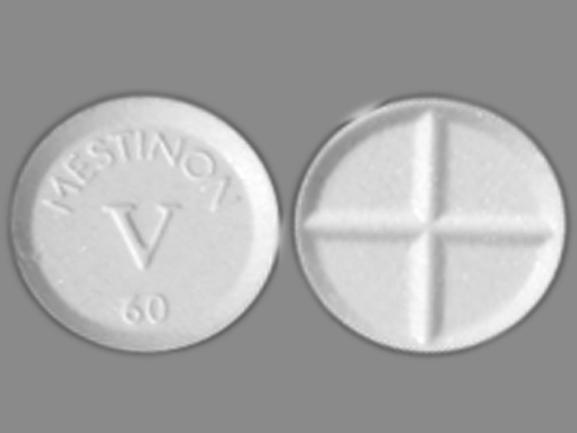Mestinon Disease Interactions
There are 5 disease interactions with Mestinon (pyridostigmine).
Cholinesterase inhibitor (applies to Mestinon) bradycardia
Major Potential Hazard, High plausibility. Applicable conditions: Arrhythmias
Due to their pharmacological action, cholinesterase inhibitors can have a vagotonic effect on the sinoatrial and atrioventricular nodes producing bradycardia or heart block. Therapy with cholinesterase inhibitors should be administered cautiously in patients with preexisting bradycardia or underlying cardiac conduction abnormalities. Syncopal episodes have been reported. Atropine may be used to reverse bradycardia produced by cholinesterase inhibitors.
Cholinesterase inhibitor (applies to Mestinon) bronchospasm
Major Potential Hazard, High plausibility. Applicable conditions: Asthma, Chronic Obstructive Pulmonary Disease
Cholinesterase inhibitors inhibit the hydrolysis of acetylcholine. The enhanced effect of acetylcholine produces constriction of the bronchi, increased bronchial secretions, and bronchospasm. Therapy with cholinesterase inhibitors should be administered cautiously in patients with respiratory dysfunction, history of asthma, or obstructive pulmonary disease. Respiratory function should be closely monitored for the occurrence of respiratory adverse reactions. Use of atropine along with discontinuation of the cholinesterase inhibitor may be required for serious respiratory distress.
Cholinesterase inhibitor (applies to Mestinon) coronary artery disease
Major Potential Hazard, High plausibility. Applicable conditions: Ischemic Heart Disease
The use of cholinesterase inhibitors has been associated with a constriction of coronary arteries. Therapy with cholinesterase inhibitors should be administered cautiously in patients with coronary artery disease.
Cholinesterase inhibitor (applies to Mestinon) parkinsonism
Major Potential Hazard, High plausibility.
Cholinesterase inhibitors should be used with caution in patients with parkinsonism. Some of these drugs might be contraindicated in these patients (refer to specific prescribing information). Symptoms of Parkinson's disease may be exacerbated with the increase in cholinergic activity. Caregivers and patients should be advised.
Cholinesterase inhibitor (applies to Mestinon) hyperthyroidism
Moderate Potential Hazard, High plausibility.
Many of the manifestations of hyperthyroidism may be exacerbated by increased levels of acetylcholine produced by cholinesterase inhibitors. Therapy with cholinesterase inhibitors should be administered cautiously to patients with hyperthyroidism. Monitoring of thyroid levels is recommended.
Switch to professional interaction data
Mestinon drug interactions
There are 100 drug interactions with Mestinon (pyridostigmine).
More about Mestinon (pyridostigmine)
- Mestinon consumer information
- Check interactions
- Compare alternatives
- Pricing & coupons
- Reviews (40)
- Drug images
- Side effects
- Dosage information
- During pregnancy
- Generic availability
- Drug class: cholinergic muscle stimulants
- Breastfeeding
- En español
Related treatment guides
Drug Interaction Classification
| Highly clinically significant. Avoid combinations; the risk of the interaction outweighs the benefit. | |
| Moderately clinically significant. Usually avoid combinations; use it only under special circumstances. | |
| Minimally clinically significant. Minimize risk; assess risk and consider an alternative drug, take steps to circumvent the interaction risk and/or institute a monitoring plan. | |
| No interaction information available. |
Further information
Always consult your healthcare provider to ensure the information displayed on this page applies to your personal circumstances.


